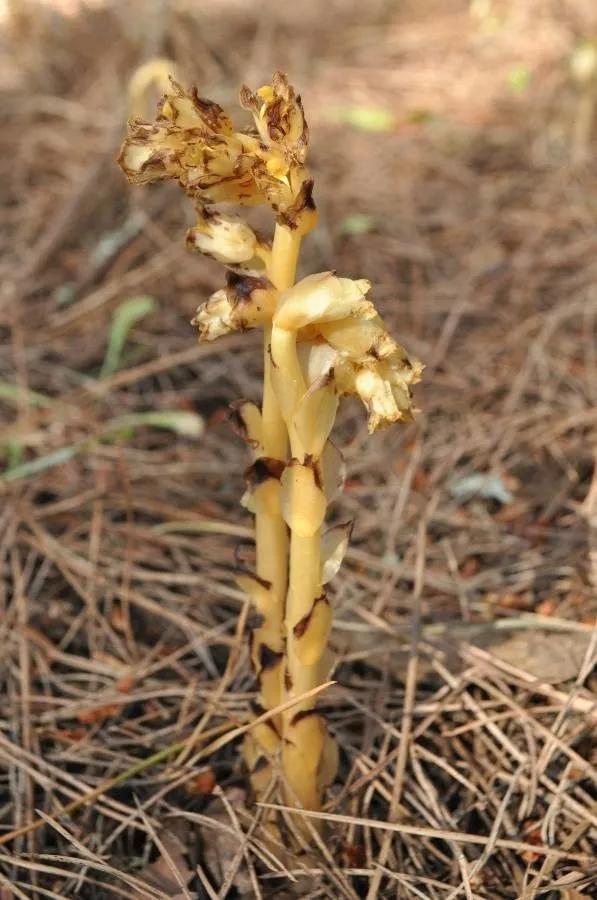
Author: L.
Bibliography: Sp. Pl.: 387 (1753)
Year: 1753
Status: accepted
Rank: species
Genus: Monotropa
Vegetable: Unknown
Observations: Temp. Northern Hemisphere to C. America
The Yellow bird’s-nest, scientifically known as Monotropa hypopitys, is a fascinating and unique plant that belongs to the family Ericaceae. First described and documented in the seminal botanical work “Species Plantarum” by Carl Linnaeus in 1753, this plant has intrigued botanists and nature enthusiasts alike for centuries.
One of the most striking features of the Yellow bird’s-nest is its appearance and lifestyle. Unlike most plants that rely on photosynthesis to produce energy, Monotropa hypopitys is mycoheterotrophic. This means it obtains its nutrients by parasitizing the mycorrhizal fungi that are associated with the roots of surrounding trees. Due to this reliance on fungal networks, the plant lacks the green pigmentation typically found in photosynthetic plants, giving it a yellow or straw-colored appearance, which lends itself to the common name “Yellow bird’s-nest.”
The habitat of Monotropa hypopitys predominantly spans the temperate regions of the Northern Hemisphere, extending as far south as Central America. This wide distribution suggests that the plant has adapted to a variety of temperate forest ecosystems, particularly favoring shaded, damp environments where mycorrhizal fungi are abundant. It is most commonly found in deciduous and mixed woodlands, thriving under the canopy where direct sunlight is scarce.
Yellow bird’s-nest produces clusters of small, waxy, bell-shaped flowers that emerge from a somewhat fleshy, unbranched stem. The flowers, which bloom from late summer to early fall, are typically pale yellow to reddish-brown and have an interesting nodding habit. The plant’s life cycle and growth pattern are closely aligned with the availability of fungal hosts, which also play a crucial role in its reproductive strategy.
While Monotropa hypopitys may not be as well-known as other members of the Ericaceae family, its unique ecological niche and non-photosynthetic lifestyle make it a subject of ongoing botanical research and interest. Its presence in an ecosystem can be indicative of the health and diversity of fungal networks within the soil, highlighting the intricate and often hidden relationships that sustain forest environments.
In summary, the Yellow bird’s-nest (Monotropa hypopitys) stands as an extraordinary plant within the Ericaceae family due to its mycoheterotrophic mode of nutrition and its distinctive appearance. Found across temperate regions of the Northern Hemisphere to Central America, it continues to captivate those who study the complex interactions within forest ecosystems.
En: Yellow Birdsnest, Yellow Birs’s-nest, Yellow bird’s-nest, Pinesap Indian pipe, Pinesap, Yellow bird’s nest
Be: Пад’ельнік звычайны
Bg: Обикновена гвачка
Ca: Monòtropa
Zh: Song xia lan, 松下兰
Hr: Obični bezlistac
Cs: Hnilák smrkový
Da: Almindelig Snylterod, Snylterod
Nl: Stofzaad, Stofzaad subsp. hypophegea, Stofzaad subsp. hypopitys
Eo: Pinasparago
Et: Harilik seenlill
Fi: Mäntykukka
Fr: Sucepin, Monotrope sucepin
De: Fichtenspargel, Echter Fichtenspargel, Behaarter Fichtenspargel
Ga: Buíán sailí
It: Ipopitide
Kk: Шыршашөп
Lv: Parastā lāčtauce
Lt: Miškinė gluosvė
Gv: Buighan shellee
Se: Beahcelieđđi
No: Vaniljerot
Nb: Vaniljerot
Nn: Vaniljerot
Pl: Korzeniówka pospolita
Ru: Подъельник обыкновенный
Gd: Buíán sailí
Sk: Hniliak smrekový
Sv: Tallört
Zh-tw: 臺灣錫杖花, 錫杖花
Zh-hant: 松下蘭
Cy: Cytwf
Taken May 18, 2019 by Javier López (cc-by-sa)
Taken Aug 18, 2021 by Ekaterina Ekaterina (cc-by-sa)
Taken Aug 23, 2022 by lachesis lachesis (cc-by-sa)
Taken Jun 12, 2020 by Isabelle Meyer (cc-by-sa)
Taken Aug 8, 2014 by Émile Maurice (cc-by-sa)
Taken Jul 3, 2021 by José Cuesta (cc-by-sa)
Taken Jun 26, 2022 by Albert Galoy (cc-by-sa)
Taken Jul 27, 2011 by Tela Botanica − Yoan MARTIN (cc-by-sa)
Taken Jul 5, 2020 by Llandrich anna (cc-by-sa)
Taken Jul 5, 2020 by Llandrich anna (cc-by-sa)
Taken Jul 11, 2020 by Matt O (cc-by-sa)
Taken Aug 7, 2016 by Tela Botanica − Yoan MARTIN (cc-by-sa)
Taken Aug 7, 2016 by Tela Botanica − Yoan MARTIN (cc-by-sa)
Taken Jul 6, 2020 by Kupková Martina (cc-by-sa)
Taken Jul 5, 2020 by Llandrich anna (cc-by-sa)
© copyright of the Board of Trustees of the Royal Botanic Gardens, Kew.
© copyright of the Board of Trustees of the Royal Botanic Gardens, Kew.
© copyright of the Board of Trustees of the Royal Botanic Gardens, Kew.
Taken May 31, 2014 by Tela Botanica − Dominique REMAUD (cc-by-sa)
Taken Apr 27, 2016 by Tela Botanica − John DE VOS (cc-by-sa)
Taken Jul 10, 2016 by Tela Botanica − Jean-Philippe MICHOT (cc-by-sa)
Taken Jun 20, 2016 by Tela Botanica − Alain CAMBIER (cc-by-sa)
Taken Jun 3, 2014 by Tela Botanica − Gérard LEVESLIN (cc-by-sa)
Taken Jul 15, 2011 by Photoflora – Jean-Jacques HOUDRE (©)
Taken Jun 30, 1852 by Tela Botanica − Herbier PONTARLIER-MARICHAL (cc-by-sa)
Taken Aug 19, 2021 by Pietro Brignoli (cc-by-sa)
Taken May 27, 2021 by Alain Bigou (cc-by-sa)
Taken Jan 1, 1970 by Photoflora – L’Abbé COSTE (©)
Taken Jul 26, 2021 by Florence Pradier (cc-by-sa)
Taken Jun 2, 2020 by Rino Crisponi (cc-by-sa)
Taken Jun 2, 2020 by Rino Crisponi (cc-by-sa)
Taken Aug 22, 2022 by Havlíková Petra (cc-by-sa)
Taken Jun 13, 2021 by Beata Zalewska (cc-by-sa)
Family: Myrtaceae Author: (F.Muell.) K.D.Hill & L.A.S.Johnson Bibliography: Telopea 6: 402 (1995) Year: 1995 Status:…
Family: Rubiaceae Author: Pierre ex A.Froehner Bibliography: Notizbl. Bot. Gart. Berlin-Dahlem 1: 237 (1897) Year:…
Family: Sapindaceae Author: Koidz. Bibliography: J. Coll. Sci. Imp. Univ. Tokyo 32(1): 38 (1911) Year:…
Family: Asteraceae Author: A.Gray Bibliography: Pacif. Railr. Rep.: 107 (1857) Year: 1857 Status: accepted Rank:…
Family: Fabaceae Author: Medik. Bibliography: Vorles. Churpfälz. Phys.-Ökon. Ges. 2: 398 (1787) Year: 1787 Status:…
Family: Aspleniaceae Author: (Cav.) Alston Bibliography: Bull. Misc. Inform. Kew 1932: 309 (1932) Year: 1932…